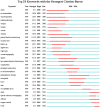Global Tendency and Frontiers of Research on Myopia From 1900 to 2020: A Bibliometrics Analysis
- PMID: 35359777
- PMCID: PMC8960427
- DOI: 10.3389/fpubh.2022.846601
Global Tendency and Frontiers of Research on Myopia From 1900 to 2020: A Bibliometrics Analysis
Erratum in
-
Corrigendum: Global tendency and frontiers of research on myopia from 1900 to 2020: A bibliometrics analysis.Front Public Health. 2022 Oct 26;10:1063615. doi: 10.3389/fpubh.2022.1063615. eCollection 2022. Front Public Health. 2022. PMID: 36388265 Free PMC article.
Abstract
Background: Myopia is one of the most common causes of vision impairment in children and adults and has become a public health priority with its growing prevalence worldwide. This study aims to identify and evaluate the global trends in myopia research of the past century and visualize the frontiers using bibliometric analysis.
Methods: The literature search was conducted on the Web of Science for myopia studies published between 1900 and 2020. Retrieved publications were analyzed in-depth by the annual publication number, prolific countries and institutions, core author and journal, and the number of citations through descriptive statistics. Collaboration networks and keywords burst were visualized by VOSviewer and CiteSpace. Myopia citation network was visualized using CitNetExplorer.
Results: In total, 11,172 publications on myopia were retrieved from 1900 to 2020, with most published by the United States. Saw SM, from the National University of Singapore, contributed the most publications and citations. Investigative Ophthalmology & Visual Science was the journal with highest number of citations. Journal of Cataract and Refractive Surgery with the maximum number of publications. The top 10 cited papers mainly focused on the epidemiology of myopia. Previous research emphasized myopia-associated experimental animal models, while recent keywords include "SMILE" and "myopia control" with the stronger burst, indicating a shift of concern from etiology to therapy and coincided with the global increment of incidence. Document citation network was clustered into six groups: "prevalence and risk factors of myopia," "surgical control of myopia," "pathogenesis of myopia," "optical interventions of myopia," "myopia and glaucoma," and "pathological myopia."
Conclusions: Bibliometrics analysis in this study could help scholars comprehend global trends of myopia research frontiers better. Hundred years of myopia research were clustered into six groups, among which "prevalence and risk factors of myopia" and "surgical control of myopia" were the largest groups. With the increasing prevalence of myopia, interventions of myopia control are a potential research hotspot and pressing public health issue.
Keywords: CitNetExplorer; bibliometric analysis; global trends; myopia; myopia control; public health; refractive surgery.
Copyright © 2022 Shan, Dong, Chen, Su and Wan.
Conflict of interest statement
The authors declare that the research was conducted in the absence of any commercial or financial relationships that could be construed as a potential conflict of interest.
Figures




References
Publication types
MeSH terms
LinkOut - more resources
Full Text Sources
Miscellaneous

